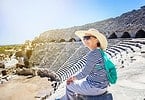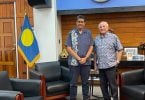There is no widespread tsunami threat in Puerto Rico, different from first reported by some media. However a local threat could be possible. A strong 6.5-magnitude earthquake struck at sea off the Puerto Rican coast at a shallow depth of less than 30 km early on Monday, the US Geological Survey reports.
The quake hit some 56 km off the northern coast of the island. The capital, San Juan, where 400,000 people live is located on the same side of the island.
No immediate injuries or damage has been reported. The tourism industry is extensive on this part of the island. The Pacific Tsunami Warning Center said the quake could trigger a local tsunami, but there is no threat for a widespread tsunami is in place.
The Puerto Rico quake on Monday comes almost exactly 4 years after a powerful 7.0-magnitude quake devastated another Caribbean island – Haiti.
The 2010 disaster took more than 100,000 lives and caused a humanitarian catastrophe in the nation, which remains one of the poorest in the world.
Seismotectonics of the Caribbean Region and Vicinity
Hoʻohālikelike ka laulā a me ka paʻakikī o nā aupuni tectonic i ka anapuni o ka papa Caribbean, e pili ana i nā papa nui ʻehā (ʻAmelika Hema, ʻAmelika Hema, Nazca, a me Cocos). ʻO nā ʻāpana piʻina o nā ʻōlaʻi hohonu (Wadati-Benioff zones), nā ʻau kai, a me nā ʻā pele o nā lua pele e hōʻike maopopo ana i ka hoʻokaʻawale ʻana o ka lithosfer moana ma nā palena o ʻAmelika Hui Pū ʻIa a me ʻAkelanika ʻAilana o ka pā Caribbean, ʻoiai ʻo ka seismicity crustal ma Guatemala, ka ʻākau o Venezuela, a me ka Cayman Hōʻike ʻo Ridge a me Cayman Trench i ka hewa a me nā tectonics ipu huki.
Ma ka ʻaoʻao ʻākau o ka pā Karipiano, neʻe ka pā o ʻAmelika ʻĀkau i ke komohana e pili ana i ka pā Karipiano ma kahi wikiwiki o 20 mm/yr. Hoʻokomo ʻia ka Motion ma kekahi mau hewa hoʻololi nui e holo ana i ka hikina mai Isla de Roatan a i Haiti, me ka Swan Island Fault a me ka Oriente Fault. Hōʻike kēia mau hewa i nā palena hema a me ka ʻākau o ka ʻauwaha Cayman. Ma ka hikina aʻe, mai ka Dominican Republic a i ka Mokupuni ʻo Barbuda, ʻoi aku ka paʻakikī o ka neʻe ʻana ma waena o ka pā ʻAmelika ʻAmelika a me ka pā Karipiano a ua hoʻokipa ʻia ʻo ia e ka hoʻohaʻahaʻa like ʻana o ka pā ʻAmelika ʻĀkau ma lalo o ka pā Karipiano. ʻO kēia ka hopena i ka hoʻokumu ʻia ʻana o ka hohonu o Puerto Rico Trench a me kahi ʻāpana o nā ōlaʻi kū waena (70-300 km hohonu) i loko o ka papa i hoʻohaʻahaʻa ʻia. ʻOiai ua manaʻo ʻia he hiki ke hoʻoulu i ka ʻōlaʻi megathrust ma Puerto Rico subduction zone, ʻaʻohe hanana like i ka makahiki i hala. ʻO ka hanana interplate (thrust fault) hope loa ma ʻaneʻi i hana ʻia ma ka lā 2 o Mei, 1787 a ua manaʻo nui ʻia a puni ka mokupuni me ka palapala luku ʻia ma nā kahakai ʻākau holoʻokoʻa, me Arecibo a me San Juan. Mai ka makahiki 1900, ʻo nā ʻōlaʻi nui loa ʻelua i hiki mai ma kēia māhele ʻo ia ka ōlaʻi ʻo ʻAukake 4, 1946 M8.0 Samana ma ka hikina ʻākau o Hispaniola a me ke ōlaʻi ʻo Iulai 29, 1943 M7.6 Mona Passage, ʻo ia mau ʻōlaʻi pāpaʻu. ʻO kahi hapa nui o ka neʻe ʻana ma waena o ʻAmelika ʻĀkau a me ka pā Karipiano ma kēia ʻāina e hoʻokipa ʻia e kahi ʻano o ka ʻaoʻao hema hema e hoʻokaʻawale i ka mokupuni ʻo Hispaniola, ʻo ia hoʻi ka Septentrional Fault ma ka ʻākau a me ka Enriquillo-Plantain. ʻO ka hewa kīhāpai ma ka hema. ʻO ka hana e pili ana i ka ʻōnaehana Enriquillo-Plantain Garden Fault ʻoi aku ka maikaʻi o ka palapala e ka ōlaʻi hoʻopōʻino o Ianuali 12, 2010 M7.0 Haiti, kona mau haʻalulu pili a me kahi ōlaʻi like i ka makahiki 1770.
Ke neʻe nei i ka hikina a me ka hema, nā piko o ka palena a puni ʻo Puerto Rico a me ka ʻĀkau ʻo Lesser Antilles kahi e emi ai ka papa neʻe o ka papa Caribbean e pili ana i nā ʻĀkau o ʻAmelika Hema a me ʻAmelika Hema, e hopena ana i nā ʻenehana tactonics mokupuni paʻa. Ma aneʻi, e hoʻohaʻahaʻa nā papa ʻĀkau a me ʻAmelika Hema i ke komohana ma lalo o ka papa Caribbean ma ka Lesser Antilles Trench ma nā kumukūʻai ma kahi o 20 mm / yr. Ma ke ʻano he hopena o kēia hoʻoliʻiliʻi, aia nā ōlaʻi waena waena ma waena o nā papa i hoʻohaʻahaʻa ʻia a me ke kaulahao o nā luaipele ʻeleu ma ka pae moku. ʻOiai ʻo ka Lesser Antilles i manaʻo ʻia ʻo ia kekahi o nā wahi seismically ʻeleu loa i ka Caribbean, ʻoi aku ka nui o kēia mau hanana i ʻoi aku ma mua o M7.0 i ke kenekulia i hala. ʻO ka mokupuni ʻo Guadeloupe kahi o kahi o nā ōlaʻi nui megathrust nui loa i kū ma kēia ʻāina ma Pepeluali 8, 1843, me ka manaʻo i ʻoi aku ka nui ma mua o 8.0. ʻO ke ōlaʻi waena waena nui loa i kū mai ma ka arc ʻo Lesser Antilles ʻo ia ka Nowemapa 29, 2007 M7.4 Martinique ʻōlaʻi komohana komohana o Fort-De-France.
The southern Caribbean plate boundary with the South America plate strikes east-west across Trinidad and western Venezuela at a relative rate of approximately 20 mm/yr. This boundary is characterized by major transform faults, including the Central Range Fault and the Boconó-San Sebastian-El Pilar Faults, and shallow seismicity. Since 1900, the largest earthquakes to occur in this region were the October 29, 1900 M7.7 Caracas earthquake, and the July 29, 1967 M6.5 earthquake near this same region. Further to the west, a broad zone of compressive deformation trends southwestward across western Venezuela and central Columbia. The plate boundary is not well defined across northwestern South America, but deformation transitions from being dominated by Caribbean/South America convergence in the east to Nazca/South America convergence in the west. The transition zone between subduction on the eastern and western margins of the Caribbean plate is characterized by diffuse seismicity involving low- to intermediate-magnitude (M<6.0) earthquakes of shallow to intermediate depth. The plate boundary offshore of Colombia is also characterized by convergence, where the Nazca plate subducts beneath South America towards the east at a rate of approximately 65 mm/yr. The January 31, 1906 M8.5 earthquake occurred on the shallowly dipping megathrust interface of this plate boundary segment. Along the western coast of Central America, the Cocos plate subducts towards the east beneath the Caribbean plate at the Middle America Trench. Convergence rates vary between 72-81 mm/yr, decreasing towards the north. This subduction results in relatively high rates of seismicity and a chain of numerous active volcanoes; intermediate-focus earthquakes occur within the subducted Cocos plate to depths of nearly 300 km. Since 1900, there have been many moderately sized intermediate-depth earthquakes in this region, including the September 7, 1915 M7.4 El Salvador and the October 5, 1950 M7.8 Costa Rica events. The boundary between the Cocos and Nazca plates is characterized by a series of north-south trending transform faults and east-west trending spreading centers. The largest and most seismically active of these transform boundaries is the Panama Fracture Zone. The Panama Fracture Zone terminates in the south at the Galapagos rift zone and in the north at the Middle America trench, where it forms part of the Cocos-Nazca-Caribbean triple junction. Earthquakes along the Panama Fracture Zone are generally shallow, low- to intermediate in magnitude (M<7.2) and are characteristically right-lateral strike-slip faulting earthquakes. Since 1900, the largest earthquake to occur along the Panama Fracture Zone was the July 26, 1962 M7.2 earthquake.






















